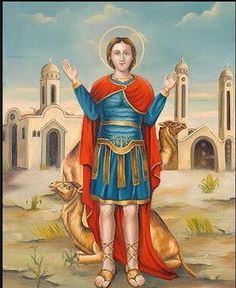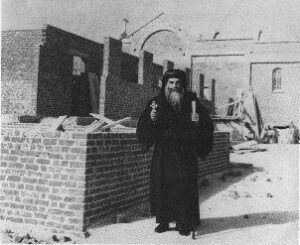St. Mina, the Martyr – June 9 / Oct 22 I The Wonder Worker and Martyr

St. Mina was born in A.D. 285 in the town Nakiyos in Egypt. His father Eudoxius, a governor and mother Euphemia were childless for long time. Euphemia went to a Church in Attrib on the feast day of the Virgin Mary and sought with tears her intercession to grant her a child. Mina was a gift to his mother, whose weeping on the feast of St. Mary, praying in front of her icon about a child was heard by God. She heard a voice come out from the icon, ‘Amen’. The mother told the story to the father, and soon enough they were blessed with a boy: They called his name “Mina” after the word ‘Amen’. Later he had a brother and a sister.
St. Mina was raised in a Christian home, and he was very well rooted in Christianity. His father died when Mina was eleven years and his mother three years later. Mina led a Christian way of life observing lent, fasting and prayers, never missing out on worship. He joined the Roman army and was given a high rank due to his father’s reputation. He went with the troops to Algeria to render his patriotic service to the nation.
Emperor Diocletian at this time ordered everyone to give up the Christian belief and to torture those who did not worship idols. He put a ban of Christianity Mina decided to quit his job in the army and to surrender his life to his Lord, Jesus. He went to the desert, staying many days to worship God. God opened his eyes, so he saw heaven open with many martyrs crowned, and he heard a voice saying “He who toils for the Name of the Lord Christ shall receive these crowns.” Immediately, he went back to his city, confessing his faith. Mina sold all his property and became an ascetic. He saw in a vision the portals of heaven opened and all martyrs being adorned with glorious crowns. Following that, he heard a voice granting him three crowns – celibacy, asceticism, and martyrdom.
Mina was offered many gifts to abjure a life dedicated to Jesus. The governor even tried to bride him, but when that did not work, the governor tried to threaten him, but as always that failed. When he refused to comply with their demand and reaffirmed his faith in Jesus, an order was soon issued to decapitate him. The governor “ordered his head to be cut off with the sword, his body to be cast in the fire and his ashes to be scattered in the wind. The body remained in the fire for three days and three nights, but it was not harmed.” This event is said to have occurred in A.D. 303.
St. Mina’s sister collected his body, by paying a sum of money to the soldiers, embarked on a ship and took the body back to Alexandria. A sea monster entered the ship, which scared the passengers and the crew. Fire emanating from the saint’s body. The beasts eventually went away because they were getting attacked. As the ship neared the port of Alexandria, a huge crowd including the Patriarch of Alexandria had gathered to welcome the saint’s remains. With great reverence, they sheathed his body in expensive clothes.
When the period of persecution came to an end, Mar Athanasius, the Patriarch of Alexandria, following a divine instruction, loaded St. Mina’s body on a camel’s back to be taken out of the town. The camel was not led by anyone as directed by the angel. People followed the camel. They heard a sound on reaching Lake Bayad in the district of Marriot, “The Lord wishes Mina’s body to be interred here.” Thereupon they performed his burial there itself.
Many years passed and when Alexandria was besieged, the Governor secretly took St. Mina’s body with him. Through the saint’s intercession, he won the war. He wished to carry the body back to Alexandria. The camel, which carried the body of the saint, knelt at his burial place near Lake Bayad. It refused to move despite being beaten. They transferred the body to another camel’s back, but they could not continue the journey. Finally, they had to bury him in the same place.
After a lapse of many years, a shepherd happened to locate the burial place of St. Mina quite accidently. One of his sheep was afflicted by mangy, a skin disease. That sheep rolled on the soil after dipping itself in water. It was miraculously cured. Thenceforth the shepherd worked a cure by applying the muddied soil of that place on the sick sheep. This story spread quickly over many places.

Upon hearing the story of the miracle, the Emperor of Constantinople sent his daughter, who was suffering from leprosy there. She too applied the muddied soil from that area upon her diseased body. At night, she heard a voice telling her ‘Get up early in the morning and dig this place. You will find my body there’. She informed her father she was healed of the dreaded disease. The place where this saint was buried had a church built over it and it became a monastery. During the reign of Roman Emperors Arcadius and Honorus, a large city was built around this area, which later came to be called Mariut. The Orthodox Syrian Church celebrates the feast of St. Mina on 9 June.

Today, St. Mina Monastery in Mariut has become the landmark of the region. The monastery has many buildings, numerous Churches/chapels, and even a big Cathedral.

0 Comments